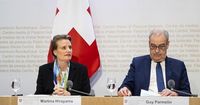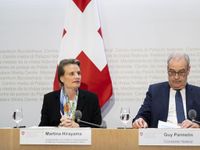The Swiss State Secretary for Education, Research and Innovation, Martina Hirayama, is set to attend a significant rocket launch in Florida on Monday, April 21, 2025. This event marks a notable collaboration between Switzerland and the United States in the realm of space research.
During the launch, a crucial piece of Swiss research material, known as the ACES (Atomic Clock Ensemble in Space) instrument, will be transported to the International Space Station (ISS) aboard a rocket developed by Elon Musk's SpaceX. The ACES instrument is designed to enhance our understanding of timekeeping in space by comparing time data collected in orbit with that on Earth.
The ACES instrument comprises two atomic clocks that send different signals. Notably, one of these clocks was developed and built in Switzerland, as confirmed by the Federal Department of Economic Affairs, Education and Research (EAER). This innovative project aims to gain valuable physical insights from the data collected during the mission, which could have broader implications for timekeeping and navigation systems.
The focus of Hirayama's visit extends beyond the rocket launch itself. She is scheduled to meet with representatives from both the US space agency NASA and the European Space Agency (ESA). These discussions are expected to foster collaborative efforts in space exploration and research, reinforcing Switzerland's commitment to contributing to international scientific advancements.
The EAER has clarified that while the fact that the ACES instrument will be launched on a SpaceX rocket is noteworthy, it is not the primary focus of Hirayama's visit. Instead, the emphasis lies on enhancing partnerships with leading space agencies and exploring opportunities for future cooperation.
Switzerland has a rich history of involvement in space exploration, often punching above its weight on the international stage. The country has contributed to numerous missions, including Nobel laureates, exoplanet telescopes, and various instruments on board over 50 space missions. This latest endeavor further cements Switzerland's status as a significant player in the global space community.
As the launch approaches, excitement builds around the potential discoveries that could arise from the ACES mission. The ability to compare timekeeping in space with that on Earth may lead to advancements in technology and scientific understanding that can benefit various fields, including telecommunications, navigation, and fundamental physics.
In conclusion, Hirayama's attendance at the SpaceX launch represents a pivotal moment for Swiss research and international collaboration in space. As nations increasingly recognize the importance of scientific cooperation, events like this highlight the potential for groundbreaking discoveries that can emerge from shared efforts in exploration and innovation.


